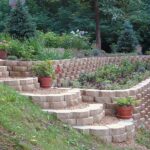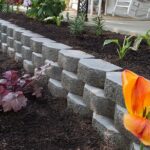A garden retaining wall is a practical and aesthetically pleasing addition to any outdoor space. These walls are used to hold back soil and create a level surface for landscaping. They can be made from a variety of materials, such as concrete, brick, or natural stone, and come in various styles and designs to suit any garden aesthetic.
One of the main benefits of a garden retaining wall is its ability to prevent soil erosion. Without a retaining wall, steep slopes or elevated landscapes can be prone to erosion from rainwater and wind. The wall acts as a barrier to keep soil in place and protect your garden plants and structures.
In addition to their functional purposes, garden retaining walls can also enhance the overall look of your outdoor space. They can be used to create terraced garden beds, add dimension to a flat yard, or define a seating or entertaining area. With the right design and materials, a retaining wall can become a focal point in your garden.
Retaining walls can also help with water drainage in your garden. By creating a barrier to hold back soil and control the flow of water, retaining walls can prevent waterlogged soil and excess moisture, which can be detrimental to plant growth. Proper drainage is essential for maintaining a healthy garden, and a retaining wall can help to achieve this.
When planning for a garden retaining wall, it is important to consider the height, location, and materials that will best suit your space. Consulting with a professional landscaping or construction company can help ensure that the retaining wall is structurally sound and meets your specific needs. Proper installation is crucial to the longevity and effectiveness of the wall.
In conclusion, a garden retaining wall is a versatile and functional addition to any outdoor space. From preventing soil erosion to enhancing the aesthetic appeal of your garden, these walls offer a range of benefits. With the right design and materials, a retaining wall can transform your garden into a more visually appealing and functional space.
















